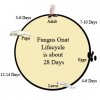hexthat
Well-Known Member

management and control
fortunately, fungus gnats are usually easily managed and can be kept in check in most orchid collections. Yellow sticky cards sold for monitoring and control of aphids and whiteflies are excellent for trapping fungus gnats. These cards are so effective when there are only a few flies that there is no need to use any insecticide on these flies. However, often female gnats will fly little so sometimes it is useful to cut strips of the cards and insert these strips into a pot to capture more of the females. Larvae are easily controlled by adjusting watering and ensuring that your orchid media is not overly decomposed and is draining well. This may require frequent repotting if you use a heavy watering regime.
The following points will help control fungus gnats:
1. Repot your plants on a regular basis and use mixes containing materials such as charcoal and coconut (fibre or
chunks) that are slow to decay, or inorganic components such as perlite;
2. Do not keep the media constantly wet and if possible allow the media to dry between waterings, especially the
upper inch or so of media.
3. Keep fertilizer to the minimum needed for the plant and adjusted to the potting media used.
Should these cultural methods not be effective or the collection be large, then alternative treatments may be warranted. However, the use of insecticidal drenches for controlling the maggots is not recommended, except as an absolutely last resort. Severe infestations of large collections may be best treated with biological control methods. The use of bacteria, nematodes, and predatory mites is highly effective in greenhouses and may work in large collections.
Bacterial treatment is most effective against the young larvae early in the cropping cycle and uses bacillus thuringiensis israelensis is sold under the trade name of gnatrol™ for greenhouse use. This type of b.t. affects only true flies (order: Diptera) and is different from the b.t. used for caterpillars in the garden. The b.t. causes paralysis of the maggots gut, stopping feeding and killing the maggot. Gnatrol™ is applied as a soil drench to thoroughly wet the soil of pots, flats, beneath benches, or other sites of infestation. It is only effective for about 48 hours so 2-3 applications may be needed with heavy infestations. Use of gnatrol™ is not recommended with simultaneous use of fertilizers or fungicides containing copper or chlorine. It will not affect the adult fungus gnats.
Parasitic nematodes are also useful for controlling fungus gnats. They enter the insect's body and multiply inside the host insect. While feeding they release a bacterium that is toxic to the host. The nematodes complete their life cycle within a few days so large numbers of infective stage nematodes are produced that will continue to search for new hosts. These beneficial nematodes can be applied as a drench to the growing media and to soil under the benches. Two common species available for greenhouse use are steinernema carpocapsae, sold as scanmask™, and steinernema feltiae, sold as nemasys™.
Finally, a small predatory mite, hypoaspsis miles also attacks fungus gnat larvae. These mites are usually sprinkled over or mixed into the potting media before planting. This mite is long-lived, will usually persist as a scavenger on dead insects while continuing to seek fungus gnat maggots, and will also feed on thrips pupae and other pests.
Chemical control of fungus gnats is diverse, but always a temporary remedy. Adults may be eliminated with any insecticide spray for flying insects, though this is decidedly a temporary fix and will not affect those adults emerging after the spray has settled. Good control of fungus gnats requires removal of the larvae, hence the high value of environmental management, i.e. Adjusting water schedules and repotting. Chemical control of larvae is best done with drenches of carbaryl, permethrin, imadichloprid, diazinon, malathion, and other common pesticides, and even isopropyl alcohol. However, and again, these are only temporary solutions as the flies will reinvade the pots once the chemical residue is degraded and the potting media remains wet and decaying.
I'm growing for my Girl Friend's mom, and Her son was taking care of her Mother plants (Lemon Larry OG and Purple Kush). When I got the keys to the grow room, I opened the door only to find Powder Mildew, Spider Mites, and Fungus Gnats. I have conquered Spider Mites and Powder Mildew, using Neem Oil and SM-90. I'm failing horrible at controlling the Fungus Gnats their numbers have doubled. I have put DE(Diatomaceous Earth) on the top layer of soil. I've noticed the females have been laying eggs in the drainage holes in at the bottom of the pots. Should I just let the soil dry up in between watering?
